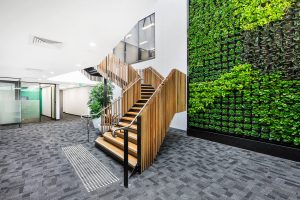Why is the rectangular desk making a comeback?
Taren Hura, Interior Designer
There’s a big difference between having a lot of space and being able to use a lot of space.
Here in Australia we have about 24 million people spread pretty thinly over roughly 7,700,000km2. Part of the reason for this is that so
much of this land mass is largely uninhabitable desert. We have come to accept this because there’s not a lot that can be done about it for the
moment and what’s more, nothing really needs to be done about it either.
Not so in commercial real estate where typically, every last square metre is costing the business money. This is why, when a team expands because of
additional demand, the handwringing commences over how best to use the available space and if possible, how to create a few more usable and very
valuable square metres.
Ignoring the L-shape in the room
Years ago, when boxy computer monitors where measured in cubic inches (maybe), work desks needed additional space to accommodate the keyboard and the
bulky screens. During those dark times, someone shed light on the benefits of an L-shaped workstation. The corners would house and hide the unsightly
rear end of the monitors while the operator could still spread their wings and enjoy desktop real estate that regular desks simply couldn’t provide.
The rise of the call centre really drove the popularity of the L-shape desk in the 90s, especially with the advent of the “quad pods” or groups
of four operators working in their partitioned workstations. As we know, it wasn’t long afterwards that flat screens and then laptops became the
norm. With them came activity-based layouts, bean bags for the Silicon Valley style vibes and hot-desks.
The point is that everything changes and continues to change which is terrific. The ways we work, think and innovate are constantly evolving which
offers designers like me, endless opportunities to do likewise. And yet… and yet for some, the one thing that is clung to like an upturned
table on a sinking ship, is the space hungry L-shaped desk.
The tale of the tape
So we’ve agreed that space is money. Most clients I speak to talk about space efficiency, getting their square meterage working harder for them, efficiency.
I think one of the big distractors that gives the L-shape desk a “free pass”, so to speak, is that we tend to talk in terms of floor space. Tape
measures are generally stretched out across the floor and floor plans themselves insist that the space underfoot is what counts. Elevating our
thinking (and tape measures) to desk height would reveal that each vacant, L-shaped apex represents around 1.2m2 (the back of those
old computers demand around 33cm x 36cm give or take). At first, that doesn’t sound like much and some could be forgiven for dismissing it as irrelevant.
Until you apply that to a 110-seat call centre for example. Then you’re left with a 132m2 memorial to boxy computer monitors that became
extinct over a decade ago.
We’re A1, OK with L-shapes
I am not calling for the abolition of L-shaped desk. Not at all. However, the idea of using rectangular work benches should not be dismissed without
due consideration. There are those that routinely work with A1 and A0 print outs – designers, engineers, architects, draftspeople, artists. They
will use the extra space afforded by the L-shape efficiently and effectively. But note: they will not be using it to house the nether regions of
screens from a (recently) bygone era.
So why the bench?
Yes, coming back to the original question. And the answer is not simply a space issue although it is a compelling one. The changes in the way we work
and what we continue to learn about how we work drives change in the workplace. Understanding that as we spend more hours per week sitting down
at a monitor, discussion opens up about the effects of the sedentary work life on our lives. Enter devices like the fitbit that tell us to get
up and walk around – get those steps up. More to the point, the sit/stand mechanisms work best under bench style desks, offering the chance for
workers to stretch their legs and literally keep them stretched, loose and active.
Bench style workspaces within the office also offer the chance to reduce the footprint. L-shapes use more primary material for building the desk and
in the case of open-plan layouts, more secondary materials for partitions are needed too. A lot to think about.
We can never know definitively, what developments are waiting for us in the future but we do know that being “future fit” means being ready to adapt
to new ways of working. Now that technology and needs have evolved, the traditional, rectangular desk seems to offer more agility, providing us
with more answers than questions. So, it’s not so much a comeback as a renaissance. And one that’s working.




